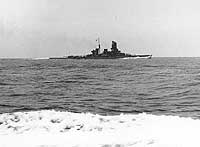
Haruna, a 26,230 ton Kongo class battlecruiser, was built at Kobe, Japan. Completed in April 1915, she operated in the Pacific during the First World War. While in the south Pacific in 1917, she was damaged by a mine laid by the German auxiliary cruiser Wolf. In 1927-28, she was modernized at Yokosuka Dockyard, emerging with only two smokestacks and a new forward superstructure, as well as with improved armament and protection. Reclassified thereafter as a battleship, Haruna was again modernized in 1933-34, this time at Kure Dockyard, raising her standard displacement to over 32,000 tons and giving her a quite up-to-date appearance. More powerful machinery and a lengthened hull gave the reconstructed ship a speed of thirty knots, making her a very useful battleship, though relatively lightly armed and armored.
During the Second World War, Haruna was extensively employed, often in company with aircraft carriers. In December 1941, she covered the invasion of Malaya. The first four months of 1942 saw her supporting the conquest of the Dutch East Indies, participating in a bombardment of Christmas Island, and participating in the Indian Ocean Raid. In June, she was part of the ill-fated Japanese carrier force during the Battle of Midway and was lightly damaged when a bomb nearly hit her stern. The Guadalcanal Campaign that began in August 1942 also brought Haruna into action. With her sister ship, Kongo, on 14 October she delivered a devastating bombardment of Henderson Field, the U.S. airfield on Guadalcanal. Later in the month, she was present during the Battle of the Santa Cruz Islands and in mid-November operated with the Japanese aircraft carrier force during the climactic Naval Battle of Guadalcanal.
Like most of the heavier Japanese warships, Haruna saw no combat during 1943 and the first five months of 1944, though she steamed north to Japan in May 1943 in response to the American landings on Attu and was in the central Pacific later in the year during the invasions of the Gilbert Islands and Bougainville. In mid-June 1944, however, the Japanese fleet was sent to counterattack the U.S. forces then assaulting Saipan. As part of the heavily-defended van carrier group, she took an active role in the ensuing Battle of the Philippine Sea and was hit by a bomb on 20 June. Haruna also participated in the Japanese Navy's final fleet action, the Battle of Leyte Gulf. She was damaged by bomb near-misses in the Sibuyan Sea on 24 October 1944, but steamed on to engage U.S. escort carriers and destroyers in the next day's Battle off Samar.
Stationed in Japanese waters by the beginning of 1945, Haruna was damaged at Kure during the U.S. carrier plane raids on 19 March. Still moored near Kure four months later, she was sunk by Task Force 38 aircraft on 28 July 1945. Haruna's wreck was scrapped after the war.
This page features all the views we have concerning the Japanese battleship Haruna.
| If you want higher resolution reproductions than the digital images presented here, see: "How to Obtain Photographic Reproductions." |
Click on the small photograph to prompt a larger view of the same image.
The following photograph shows Haruna as a battlecruiser, in her initial three smokestack configuration:
The pictures immediately below depict Haruna as a battleship in the period 1928-33, following her first modernization:
The remaining photographs on this page show Haruna after her 1933-34 modernization and during World War II:
|
Photo #: NH 73073 Haruna (Japanese Battleship, 1915) Steaming at high speed, following her 1933-34 modernization. Donation of Kazutoshi Hando, 1970. U.S. Naval History and Heritage Command Photograph. Online Image: 90KB; 740 x 570 pixels |
 |
|
Photo #: NH 73074 Haruna (Japanese Battleship, 1915), at right, and Yamashiro (Japanese Battleship, 1917), at left Photographed circa the later 1930s. Donation of Kazutoshi Hando, 1970. U.S. Naval History and Heritage Command Photograph. Online Image: 113KB; 740 x 570 pixels |
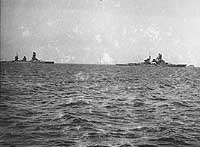 |
|
Photo #: NH 90773 Yamashiro (Japanese Battleship, 1917) In Tokyo Bay, Japan, after 1935. Behind her are the battleships Fuso and Haruna (most distant). Faintly visible in the right distance are two cruisers and an aircraft carrier. The original print came from Office of Naval Intelligence files. U.S. Naval History and Heritage Command Photograph. Online Image: 70KB; 740 x 545 pixels |
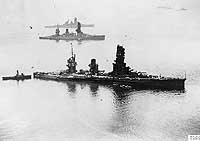 |
|
Photo #: 80-G-231831 Battle of the Philippine Sea, June 1944 Japanese Carrier Division Three under attack by Task Force 38 planes, 20 June 1944. The battleship in the lower center is either Haruna or Kongo. The carrier Chiyoda is at right. Photographed from a USS Bunker Hill (CV-17) plane. Official U.S. Navy Photograph, now in the collections of the National Archives. Online Image: 89KB; 740 x 625 pixels Reproductions of this image may also be available through the National Archives photographic reproduction system. |
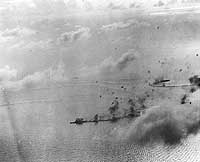 |
|
Photo #: 80-G-490226 Third Fleet Raids on Japan, July 1945 U.S. Navy carrier aircraft attack the Japanese battleship Haruna at her moorings near Kure, Japan, 28 July 1945. Photographed from a USS Intrepid (CV-11) plane. Official U.S. Navy Photograph, now in the collections of the National Archives. Online Image: 137KB; 740 x 605 pixels Reproductions of this image may also be available through the National Archives photographic reproduction system. |
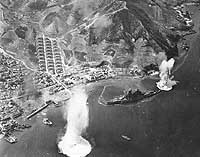 |
|
Photo #: 80-G-490224 Third Fleet Raids on Japan, July 1945 Japanese battleship Haruna under intense attack by U.S. Navy carrier-based aircraft, near Kure, Japan, 28 July 1945. Official U.S. Navy Photograph, now in the collections of the National Archives. Online Image: 102KB; 740 x 605 pixels Reproductions of this image may also be available through the National Archives photographic reproduction system. |
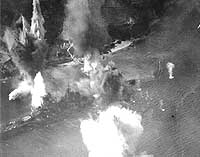 |
|
Photo #: 80-G-351726 Haruna (Japanese Battleship, 1915) On the bottom near Kure, Japan, on 8 October 1945. She had been sunk by carrier plane attacks on 28 July 1945. Note the small vessel "beached" on her forecastle, and the tree limbs mounted on her decks and superstructure as a camouflage measure. Official U.S. Navy Photograph, now in the collections of the National Archives. Online Image: 54KB; 610 x 765 pixels Reproductions of this image may also be available through the National Archives photographic reproduction system. |
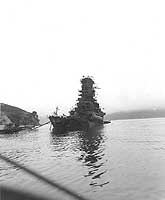 |
NOTES:
| If you want higher resolution reproductions than the digital images presented here, see: "How to Obtain Photographic Reproductions." |
Page made 30 December 2001
Coding updated 3 May 2009